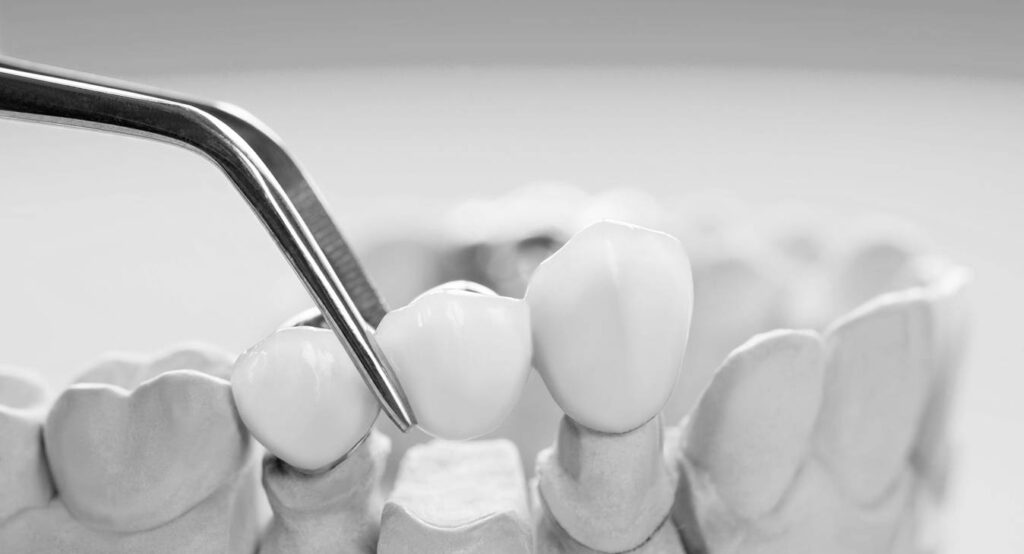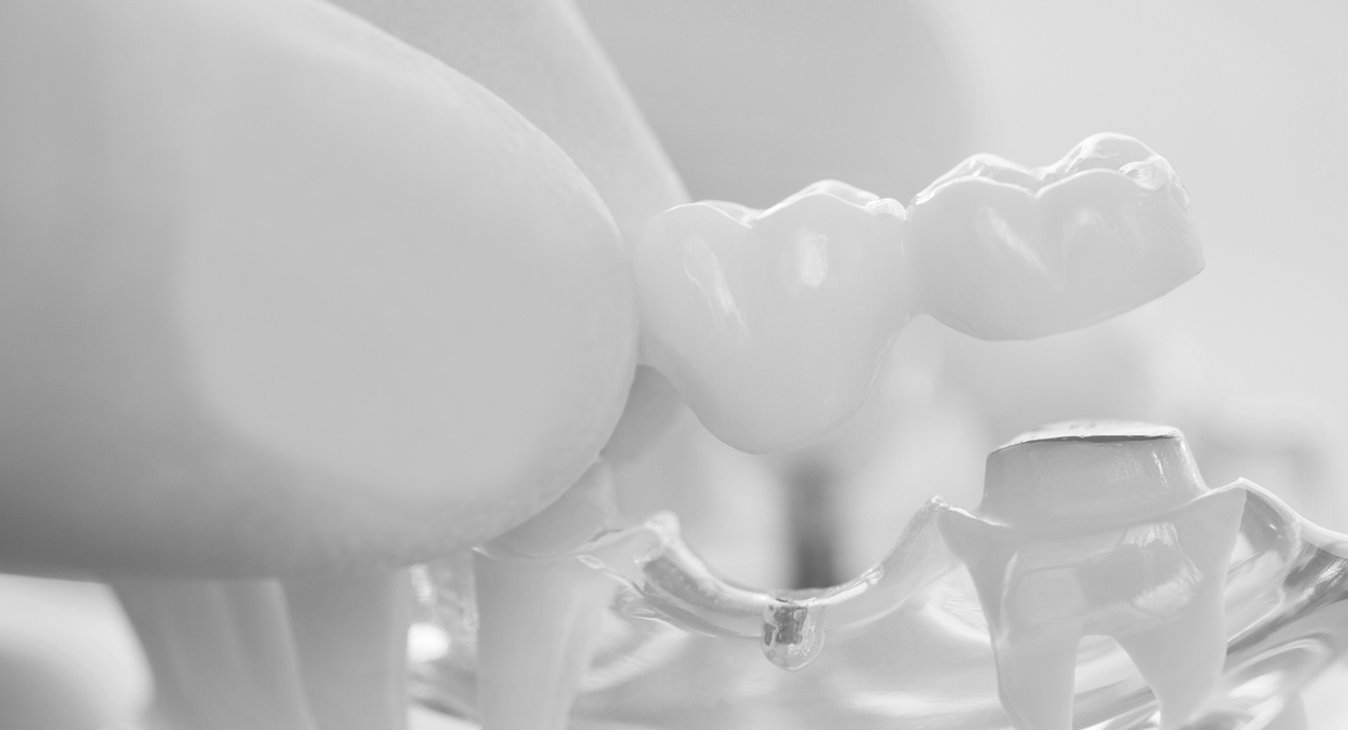Wat Is a Dental Bridge?
A dental bridge is a fixed dental restoration used to replace one or more missing teeth by joining an artificial tooth definitively to adjacent teeth or dental implants. The bridge fills the gap created by missing teeth, restoring function and aesthetics. Typically, a dental bridge consists of two crowns on either side of the gap, anchoring the artificial tooth, known as a pontic, in place. This solution helps maintain the shape of your face, prevents remaining teeth from drifting out of position, and improves chewing and speaking abilities.
What You Need to Know When Opting for Dental Bridges.
Every year, many people choose to get a dental bridge while in Buenos Aires. On this page, you’ll find helpful information about the process — including how long it typically takes, what to keep in mind, and general cost insights to help you prepare.
- Benefits of Dental Bridges Abroad
- The Procedure for a Dental Bridge
- Costs of Dental Bridges Abroad


Why Opting for a Dental Bridge in Argentina.
There are plenty of places across Latin America — and even within Argentina — where you could get a dental bridge. So why do many people choose Buenos Aires? We’ve explored this question, along with other benefits of getting dental care in the city, on a separate page to help you get a better feel for what to expect.
The Benefits of Dental Bridges and Getting Them Abroad.
Besides the general benefits of dental work abroad, there are specific reasons to consider getting dental bridges overseas. We’ve briefly highlighted them here for your information.
High Quality Dental Expertise
In Buenos Aires, many dentists take real care when it comes to planning and placing your dental bridge. A well-fitted bridge isn’t just about looks — it helps protect your overall oral health and makes everyday things like eating and speaking more comfortable. Your dentist will walk you through each step and make sure the bridge fits in a way that feels natural and works well for your smile.
Advanced Technology Usage
Clinics in Buenos Aires often use advanced technology — like digital scans and CAD/CAM systems — to help design your dental bridge with accuracy. What this means for you is usually a smoother experience, with fewer appointments and a better fit. Many patients say they’re surprised at how comfortable the process feels, thanks to the use of these modern tools.
Comprehensive Consultations
From the moment you book a consultation, care in Buenos Aires tends to be personal and clear. Dentists often take time to listen, explain your options, and make sure you feel comfortable before moving forward. Every part of the treatment is tailored to your situation — so you know what’s happening and why, every step of the way.
Treatment Customizations
When it comes to materials, you’ll have a few options to choose from — including porcelain, ceramic, metal, or composite. Your dentist will talk you through the pros and cons of each one and help you decide what feels right for your smile. The goal is to find something that blends in well and holds up over time.
Streamlined Dental Process
If you’re traveling to Buenos Aires for treatment, many clinics offer digital consultations to help you plan things in advance. Once you’re in the city, appointments are often arranged around your schedule, making it easier to fit your dental care into your trip without feeling rushed.
Patient Centricity
Getting a dental bridge usually involves more than one visit, and the clinics we work with understand how important it is to feel supported throughout the process. Many have multilingual staff who are used to helping international patients feel at ease. You can expect clear communication, thoughtful follow-ups, and a calm, caring approach from start to finish.
Dental Bridges Procedures.
As with other more complex dental treatments, the procedure of getting a dental bridge in a foreign country is slightly different than at home. For example, it requires careful planning your treatment. Within this section all the steps in the procedure of dental bridges are outlined. If you wish a more personal guidance of what to expect, please have a chat with us.
Steps Before, During and After
a Dental Bridge Treatment.
Aside from the timeline we have provided above, we will go through the procedure of a dental bridge step by step. In this section we give more details on each treatment step in the procedure to get you well informed.
Online Video Intake
Before you even pack your bags, you can start your dental bridge journey from the comfort of your home. Our partner clinics in Buenos Aires offer free online video intake consultations. During this session, a dentist will assess your dental health, discuss your goals, and explain the procedure. This helps ensure you’re well-prepared and that your treatment plan is tailored to your needs.
Initial In-Office Consultation
Within this step, your dentist will welcome you in their clinic to discuss the consultation and line-up for a personal treatment plan. Your wishes are again being discussed, and as well the price of the treatments is lay-out transparently. Within this consultation, also additional information is gathered, such as taking extra photos in case necessary.
A Personalized Treatment Plan
Based on your consultation, a personalized treatment plan is developed. This outlines the timeline and steps involved, from initial preparation to the final fitting of your dental bridge. Having a clear plan helps you understand what to expect and ensures a smoother experience upon arrival in Buenos Aires.
Temporary Bridge Placement
In some cases, a temporary bridge may be placed while your permanent one is being crafted. This protects the prepared teeth and maintains the aesthetics of your smile, allowing you to function normally until your permanent bridge is ready.
Final Fitting and Adjustments
Once your permanent dental bridge is ready, it will be fitted and cemented into place. The dentist will make any necessary adjustments to ensure a perfect fit and comfortable bite. This step is crucial for the long-term success of the bridge, ensuring it functions seamlessly with your natural teeth.
Post-Procedure Care
After your dental bridge is fitted, you’ll receive detailed care instructions to ensure proper healing and maintenance. Regular follow-up visits, which can also be conducted online, are recommended to monitor the bridge and your overall oral health. Proper care and hygiene practices will help extend the life of your dental bridge and maintain your beautiful smile.
Dental Bridge Prices: Argentina vs. United States.
Aside from the high quality of care in Buenos Aires and Argentina in general, the prices of dental bridges are affordable. Especially if you would compare them to the United States and Canada. Below we have made this comparison for you with indicative prices.
| Dental Bridge Procedures | US & Canada | Argentina |
|---|---|---|
| Initial Consultation | $100-$200 | $50-$100 |
| Dental X-rays | $50-$200 | $20-$50 |
| Tooth Preparation (Abutment Teeth) | $300-$800 | $150-$400 |
| Impressions (Digital or Physical) | $200-$500 | $100-$300 |
| Temporary Bridge | $100-$300 | $50-$150 |
| Permanent Bridge (Porcelain or Zirconia) | $1,500-$5,000 | $700-$2,500 |
| Post-Treatment Care | $50-$150 | $20-$100 |
| Total Cost of a 3-Unit Dental Bridge | $2,300-$7,150 | $1,090-$3,600 |

Will My Dental Bridge Treatment be Insured?
Dental bridges are often considered major restorative procedures. Many dental insurance plans cover a portion of the cost, typically around 50%, depending on your specific policy. However, coverage can vary, and some plans may have waiting periods or annual maximums. It’s advisable to check with your insurance provider to understand your coverage details before proceeding with treatment.
Choosing a Clinic for Dental Bridges
in Buenos Aires and Argentina.
Since 2013, our partner clinics in Buenos Aires have focused on cosmetic and aesthetic dentistry, including dental bridges. Patients appreciate the combination of high-quality care, personalized service, and affordability. Many have shared positive experiences, highlighting the professionalism and comfort
Detailed Guide
To Choose a Dental
Clinic Abroad
Advanced Diagnostics & Planning.
Why It’s Important: Getting your dental bridge right starts with seeing the full picture — literally. Advanced diagnostics, like 3D scans and digital X-rays, provide a detailed view of your mouth. This helps dentists plan precisely and tailor the treatment to your needs. A well-fitted bridge isn’t just more comfortable — it’s more likely to last and work properly over time.
What to Look For: Ask if the clinic uses digital tools to diagnose and plan treatments. These technologies help the dentist see how your teeth and bite interact, which is essential for a bridge that feels natural and functions well. It’s this careful planning that sets the stage for a long-lasting result.
Expertise in Prosthodontics.
Why It’s Important: Prosthodontists are the dental specialists who focus on restoring and replacing teeth — and that includes dental bridges. Their training goes beyond general dentistry, allowing them to create restorations that fit precisely, feel comfortable, and function just like your natural teeth. When a dental bridge is done by someone with this level of expertise, the chances of complications go down, and the result is often more durable and natural-looking.
What to Look For: When exploring clinics, make sure prosthodontists — or dentists with extra training in prosthodontics — are part of the team. Their background matters. Look for evidence of ongoing education, solid patient feedback, and clear experience with bridges. This gives you peace of mind that your care will reflect up-to-date methods and high-quality standards.
- Check Experience with Bridges
- Certifications of Prosthodontist
- Check Before and After Photos
- A Detailed Treatment Plan is Key
Key Elements When Getting a Dental Bridge Abroad.
Aside from choosing a safe and affordable clinic for your dental bridge in Buenos Aires, there are other key factors to keep in mind when considering this dental treatment. We listed them here.
Customization of Bridges
Why It’s Important:
A dental bridge should blend naturally with your teeth in color, shape, and size to ensure both comfort and function. A well-fitted bridge helps maintain proper bite alignment, making chewing feel natural while preventing future dental issues. Customization is key to making sure your bridge feels right and looks like a natural part of your smile.
What to Look For:
Choose a clinic that offers personalized treatment plans and uses advanced technology like digital impressions and CAD/CAM systems for precise customization. Shade guides should be available to match the color of your natural teeth, ensuring a result that looks and feels right. The right approach helps create a bridge that fits comfortably and functions properly in your daily life.
Variety of Material Options
Why It’s Important: Different materials offer different strengths and looks. Whether you need more durability for back teeth or a lifelike appearance for a front bridge, having options matters. The right material supports your bite, matches your natural teeth, and plays a role in long-term success..
What to Look For: Look for a clinic that walks you through the available materials and explains the pros and cons of each. Whether it’s porcelain, zirconia, or a hybrid solution, having choices allows your bridge to be built around your lifestyle and dental goals.
Fitting to Existing Dental Work
Why It’s Important: If you’ve had crowns, implants, or other restorations in the past, your new bridge needs to align well with them. Poor coordination can lead to discomfort, misalignment, or even more dental work down the line. A bridge that fits well helps protect both your bite and your oral health.
What to Look For: Choose a clinic with a track record of working with complex cases. They should be comfortable adjusting the new bridge to integrate with any existing restorations. If they can show before-and-after cases or explain how they approach these situations, that’s a strong sign of their capability.
Laboratory Collaboration
Why It’s Important: The lab that builds your bridge is just as important as the dentist who plans it. High-quality dental labs — especially those working closely with the clinic or on-site — can create bridges that fit more precisely, look more natural, and need fewer adjustments.
What to Look For: Find out whether the clinic has a dental lab on-site or works directly with a trusted partner. Ask if they use modern equipment and follow strict quality control. This behind-the-scenes detail can have a big impact on the final result you see — and feel.
Post-Treatment Support
Why It’s Important: Even after your dental bridge is placed, small tweaks may be needed over time. A strong aftercare approach helps catch these early. Regular check-ins also keep your overall oral health on track, helping your bridge last longer and stay comfortable.
What to Look For: Check that the clinic offers scheduled follow-ups and is easy to reach in case something comes up. Clinics with a solid post-treatment process can make you feel supported long after you leave the chair — whether in person or online.
Education and Preventive Care
Why It’s Important:
Your dental bridge may need adjustments over time to ensure it stays comfortable and functions properly. Regular follow-ups help address any minor issues before they become bigger problems. Ongoing support can make a difference in how well your bridge fits and how long it lasts, keeping your smile feeling natural and secure. In addition, understanding how to care for your dental bridge and prevent future issues is critical to its longevity. Proper maintenance and preventive care can significantly extend the life of your dental bridge and keep your oral health in top condition.
What to Look For:
Choose a clinic that offers thorough post-treatment care, including scheduled follow-ups and any necessary adjustments. A reliable aftercare plan helps maintain the long-term success of your bridge. Flexible scheduling and a responsive team make it easier to get the support you need if any concerns come up after your treatment.
Why People Choose Teeth Traveler
For Their Dental Bridge.
Since 2013, many of the clinics we work with have focused on cosmetic and aesthetic dentistry, including dental bridges. Patients often value the care, comfort, and clear communication they receive. While Teeth Traveler doesn’t provide dental care, we help connect you with independent clinics that do.
Discover Why
Patients Choose Us
Dental Bridge Prices at Our Clinic.
Affordable and Durable.
Clinics listed on our platform may offer price indications for dental bridges, but exact costs depend on your oral health and needs. A clear plan is usually developed after an intake consultation. Teeth Traveler doesn’t offer treatments or pricing — we simply connect you with clinics that do.
Bridge Basics
Treatment duration between 1-3 daysSame Day Treatment
*Price per Tooth in the Bridge
-
Scan & Pro-Cleaning
-
Porcelain to Metal Bridge*
-
Online Aftercare
-
Follow-up Dentistry at Home
-
Material Guarantee
*Full Porcelain 3-unit Bridge Structure
A Direct Agreement with The Dentist
Bridge Bright
Treatment duration between 1-3 daysSame Day Treatment
*Price per Tooth in the Bridge
-
Scan & Pro-Cleaning
-
Full Porcelain Bridge*
-
Professional Whitening
-
Follow-up Dentistry at Home
-
Material Guarantee
*Full Porcelain 3-unit Bridge Structure
A Direct Agreement with The Dentist
Bridge Pro
Treatment duration between 2-3 daysSame Day Treatment
Denture Supported by Metal
-
Bridge Bright
-
Full Porcelain Bridge
-
Smile Makeover Light*
-
Follow-up Dentistry at Home
-
Material Guarantee
*Includes a Whitening and Full Bondings
A Direct Agreement with The Dentist
Patient Reviews on Dental Bridges.
One of our favourite sections on the pages of our website: the reviews of patients. Why? Because we are proud and happy to share the review of all the people who left our clinic with a smile and where grateful for the work we did.





Plan an Intake.
Online. For Free.
If you’re exploring whether a dental bridge might suit your needs, the clinics we work with offer free online intake consultations. It’s a simple way to ask questions, understand your options, and receive a personalized cost estimate — directly from the clinic.
Frequently Asked Questions (FAQs) on Dental Bridges.
In this section we will try to at answer the most frequently asked questions about dental bridges. If your question is not there, give us a buzz by Whatsapp.
How much is a dental bridge in Argentina?
A dental bridge in Argentina typically costs between $500 to $1,500 per tooth, depending on the materials used and the complexity of the procedure. Porcelain bridges tend to be on the higher end of the price range. Dental bridges are a cost-effective solution for replacing missing teeth, offering both functionality and aesthetic appeal.
What is the alternative to a dental bridge?
An alternative to a dental bridge is a dental implant, which offers a long-lasting and natural-looking solution for missing teeth. Unlike bridges, implants do not require adjacent teeth to be altered. Another option is a partial denture, which is removable and less invasive, but may not provide the same level of stability as implants.
What is the least invasive dental bridge?
The least invasive type of dental bridge is the Maryland Bridge, also known as a resin-bonded bridge. This bridge uses a metal or porcelain framework that is bonded to the back of adjacent teeth, minimizing the need for extensive preparation or alteration of surrounding teeth. It’s typically used for replacing front teeth.
What is the cheapest type of dental bridge?
The most affordable type of dental bridge is typically the Maryland bridge, which usually costs less than other options. It involves minimal preparation and uses a metal or porcelain framework bonded to the back of adjacent teeth, making it a cost-effective choice for replacing missing front teeth.
Who is not a good candidate for a dental bridge?
Dental bridges may not be suitable for individuals with advanced gum disease, significant bone loss, or untreated dental infections. Patients who have weakened teeth or insufficient tooth structure to support a bridge are also not ideal candidates. Additionally, those with poor overall oral hygiene or health conditions affecting gum healing should consider alternative options.
Is a removable bridge better than a permanent bridge?
A permanent dental bridge is generally preferred over a removable bridge due to its stability, safety, and natural appearance. Permanent bridges are fixed in place, offering better durability and comfort compared to removable options, which may need more frequent adjustments and replacements. However, the choice depends on individual needs, preferences, and dental health.
Which is less expensive a bridge or implant?
A dental bridge typically has a lower upfront cost compared to a dental implant. However, over a lifetime, implants may be more cost-effective because they are more durable and can last a lifetime, whereas bridges often need replacement every 10 to 15 years, leading to higher long-term costs.
Does a fixed bridge cause bad breath?
A fixed dental bridge can cause bad breath if not cleaned properly, as food particles and bacteria can accumulate around the bridge. However, with regular and thorough oral hygiene, including brushing, flossing, and using an antibacterial mouthwash, a fixed bridge itself should not lead to bad breath. Proper care is key to maintaining fresh breath and the longevity of the bridge.
Ask Your Question
At Teeth Traveler, we’re here to share helpful information — not to offer medical advice. This information on this page is for general informational purposes only and does not constitute medical advice, diagnosis, or treatment. Teeth Traveler is not a healthcare provider and does not offer medical services. The clinics listed on our platform operate independently and are responsible for the care they provide. While we aim to offer helpful guidance, readers are encouraged to consult directly with licensed dental professionals before making healthcare decisions or pursuing treatment abroad. No rights may be derived from the information provided on this page. For more details, check our disclaimer and terms of use.
